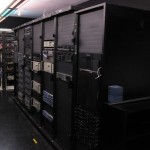 Having optimized my air flow situation in the server room, the next step was to get that cold air into the servers. I have never been a fan or believer of using cabinet blanks to block off air-flow because I always thought that having air move through and around servers served a good purpose. Most of the areas I knew had ample amounts of cold air and blocking a few cabinet holes was costly and unnecessary. I talked this over with Bob, and for the most part he agreed with me. However, this is where they pay off.
Having optimized my air flow situation in the server room, the next step was to get that cold air into the servers. I have never been a fan or believer of using cabinet blanks to block off air-flow because I always thought that having air move through and around servers served a good purpose. Most of the areas I knew had ample amounts of cold air and blocking a few cabinet holes was costly and unnecessary. I talked this over with Bob, and for the most part he agreed with me. However, this is where they pay off.
Times have changed. We are living in a world where over-building a server room and having excess A/C and power is a thing of the past. We need to use our resources wisely and minimize our costs and impact to the environment. So, we decided that we needed to force the cold air to where it was needed and that was inside the servers and appliances in the cabinets. The only way this cold air was going to get out of our cold-air aisle was to be sucked through the servers with their fans and air-flow controls. My bigger concern was that we had a large number of blanks in our cabinets as part of our recent virtualization efforts and all of the cabinet blanks that I have ever seen or heard of were fairly expensive.
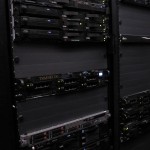 That is where experience pays off. Bob told me to look for cardboard blanks that could easily be cut and fit into the cabinets at a fraction of the cost of metal or plastic blanks. That sounded great, but I could not find such a system anywhere. Bob had used them in other situations, but was unable to recall the manufacturer. However, he was able to remember the name of a value-added reseller named Mirapath that handles products and services for providing data center and lab infrastructure solutions. We contacted Mirapath and they told us about PlenaFill. These are 27U
That is where experience pays off. Bob told me to look for cardboard blanks that could easily be cut and fit into the cabinets at a fraction of the cost of metal or plastic blanks. That sounded great, but I could not find such a system anywhere. Bob had used them in other situations, but was unable to recall the manufacturer. However, he was able to remember the name of a value-added reseller named Mirapath that handles products and services for providing data center and lab infrastructure solutions. We contacted Mirapath and they told us about PlenaFill. These are 27U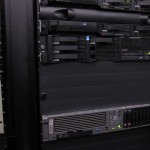 blanking panels made of a thin paper/cardboard material that is only 0.040″ thick and UL-VO class 94 fire rated. This was perfect! We just need to block air movement through the cabinets and this material can be cut to any size we need. No guess work since the panels are perforated on each rack unit for easy customization.
blanking panels made of a thin paper/cardboard material that is only 0.040″ thick and UL-VO class 94 fire rated. This was perfect! We just need to block air movement through the cabinets and this material can be cut to any size we need. No guess work since the panels are perforated on each rack unit for easy customization.
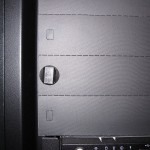 The blanks come with plastic pins that are easily pushed into the cabinet rack holes and keeps the panels in place. It literally took only seconds to cut the blanks to the proper size and insert them into the cabinets.
The blanks come with plastic pins that are easily pushed into the cabinet rack holes and keeps the panels in place. It literally took only seconds to cut the blanks to the proper size and insert them into the cabinets.
What a difference they made. We immediately noticed a huge change in the air flow of the server room and the exhaust from the servers went down in temperature very quickly. Our monitoring results on our devices clearly showed that the temperatures on the motherboards and disk arrays went down at least 15%-20%. I was stunned and extremely pleased with this.
We asked our VAR about other options for small blanks. It would be a little difficult and a waste to cut some of these panels down to 1U or 2U pieces when needed. We were looking for inexpensive options for these types of areas. They told us about HotLok blanking panels that come in 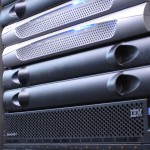 1U and 2U sizes. These are low cost plastic panels that snap into the rack mount holes in the cabinets and they are easy to install and move.
1U and 2U sizes. These are low cost plastic panels that snap into the rack mount holes in the cabinets and they are easy to install and move.
So, for very little work and cost, we were able to significantly improve the efficiency of our air conditioning requirements and made the server room far more efficient. We can easily scale this room to over 2x its current usage and keep it running without increasing our costs or environmental impact.
But, we’re not done yet. There is still more that can be done to optimize this environment and reduce costs. Leakage of air at the ends of the cold aisle and over the tops of the cabinets still needs to be addressed.
Related articles by Zemanta
- Building Up: Nine-Foot High Server Racks (datacenterknowledge.com)

![Reblog this post [with Zemanta]](http://img.zemanta.com/reblog_e.png?x-id=b2ab6d35-b410-4415-9af2-44d1f98a3b15)

Pingback: Tweets that mention Building a Green Server Room – Push Air Where You Need It -- Topsy.com()